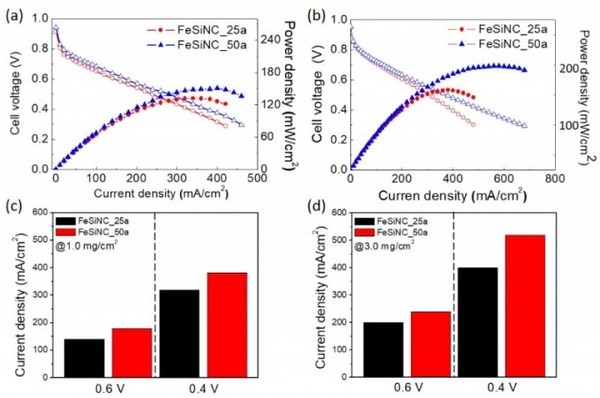Published in the "Journal of Materials Chemistry A", an international materials chemistry academic journal
The Department of Chemical and Molecular Engineering's Professors Yoo Won-cheol and Lee Sang-wook's research team developed a high-efficiency, low-cost non-platinum electrochemical catalyst to commercialize hydrogen fuel cells. This research was supported by the Gyeonggi-do Regional Research Center (GRRC), an Industry-University-Academic Cooperation Foundation.
The research was performed jointly with the Korea Institute of Science and Technology's (KIST) Professor Yoo Sung-jong research team. The GRRC announced on March 5 that they developed a non-platinum electrochemical catalyst that can replace the platinum oxidation catalyst while performing research on the core material for hydrogen energy full-cycle.
Hydrogen energy refers to the electric energy formed when hydrogen ions and oxygen meet to form water. Then, acatalyst is necessary to help facilitate the chemical reaction and only platinum was used for that. However, as platinum is very costly, there were limits to its commercialization.
The research team synthesized a simple atom catalyst carbon (FeSiNC) that was co-doped (a process of adding a small amount of an element or chemical to control the structural characteristic of certain materials) with new iron (Fe), silicon (Si), and nitrogen (N), and confirmed that this could replace the previous catalyst at a low cost.
Furthermore, they explained the outstanding oxidation result by performing computer simulation research of the research and digitizing. By producing and testing the capacity of the anion exchange membrane fuel cell, which is one type of fuel cell, they confirmed the experimental base for commercializing low-cost, high-efficiency non-platinum catalysts.
Professors Yoo Won-cheol and Lee Sang-wook's research team said, “We created a new ground base for developing a highly economic and efficient non-platinum catalyst that can replace the costly platinum-based electric chemical catalyst, which was a huge obstacle in commercializing fuel cells for utilizing a nation-wide hydrogen energy.”
The research result was published in the "Journal of Materials Chemistry A", a prominent international academic journal in materials chemistry, on February 21st.
Meanwhile, the GRRC project is an industry-university-academic cooperation business model that Gyeonggi-do holds to connect regional universities, research labs, and medium-sized businesses and supports technological development activities in order to support companies with an insufficient research development base. This year, the support budget is 5.27 billion won, which is 510 million won for each center, and ten centers including the ERICA Campus are actively performing research development.

Click to see the Journal Article
https://pubs.rsc.org/en/content/articlelanding/2021/TA/D0TA11208A#!divAbstract

